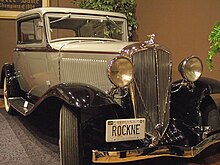Rockne
Rockne was an American automobile brand operated by Studebaker Corporation in South Bend, Indiana from February 1932 to Easter 1933 . It was named after Knute Rockne , the football coach at the University of Notre Dame .
description
Negotiations between Studebaker and Knute Rockne began in 1928. Rockne was offered a lucrative job at Studebaker by Chairman Albert R. Erskine . Meanwhile, Studebaker made plans to make a durable, cheap car named after the football coach. The Rockne should replace the hard to sell and for its market segment too expensive Erskine , which Studebaker was producing at the time.
On March 31, 1931, twelve days after being appointed sales manager, Knute Rockne died in a plane crash. In September 1931, George M. Graham , who previously worked for Willys-Overland , was appointed sales director for the new Rockne Motor Corporation . Two models went into production: the "65" with a 2,794 mm wheelbase and the "75" with a 2,896 mm wheelbase. The "75" was based on the Studebaker Six, while the "65" was designed by two engineers who worked for Willys-Overland. When Willys-Overland informed them that they had no money to make the car, they tried to sell the construction elsewhere. Studebaker's chairman, Albert R. Erskine, was impressed with the plans and bought the car and engineering. The "75" was designed under the direction of Delmar "Barney" Roos , Studebaker's technical director.
Production of the Rockne "75" began on December 15, 1931 in South Bend. The smaller "65" was manufactured from February 22, 1932 in the old EMF plant on Piquette Avenue in Detroit . The Erskine vehicles were also built there in 1927 and 1928 . The Rockne was also produced at Studebaker's Canadian facility in Windsor, Ontario .
In 1933 the model range was reduced to one series, the "10". The Rockne "10" was a revised "65". When Studebaker filed for settlement on March 18, 1933, it was decided to move production of the Rockne to the factory in South Bend. The Rockne "10" was built there from April to July 1933.
The engine of the Rockne "65" or "10" was supposed to replace all six-cylinder engines made up to then and to power cars and trucks from Studebaker until 1961.
Although the Rockne was not a success, its failure was due to the circumstances at the time. In 1932 the depression reached its lowest point; this was not a good time to start a new brand name. That year, Studebaker and its affiliates lost $ 8.7 million, which would have hurt Studebaker badly if Erskine hadn't paid high dividends in the previous three years. During that time, Erskine and Studebaker paid out $ 10 million more in dividends than the companies made. Working capital fell from $ 26 million in 1926 to $ 3.5 million in 1932. Bank debt was $ 6 million and banks wanted to see money. But Studebaker couldn't do that.
Albert R. Erskine was forced out of his position at Studebaker, had US $ 350,000 in personal debt, and found his Studebaker stock to be worthless. Since 1933 he committed on June 30 suicide . His $ 900,000 life insurance policy covered all of his debts.
Remaining Rockne were sent to Norway as CKD kits , where they were assembled and sold.
literature
- James H. Maloney: Studebaker Cars. Crestline Books, 1994, ISBN 0-87938-884-6 .
- Richard Langworth: Studebaker, the Postwar Years. Motorbooks International, 1979, ISBN 0-87938-058-6 .
- Beverly R. Kimes (Ed.), Henry A. Clark: The Standard Catalog of American Cars 1805-1942. Krause Publications, 1996, ISBN 0-87341-428-4 .
- William A. Cannon, Fred K. Fox: Studebaker: The Complete History. TAB Books, 1981, ISBN 0-8306-2064-8 .
